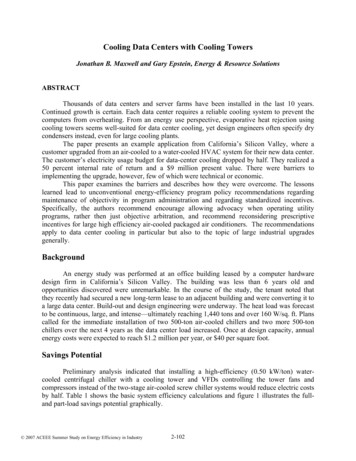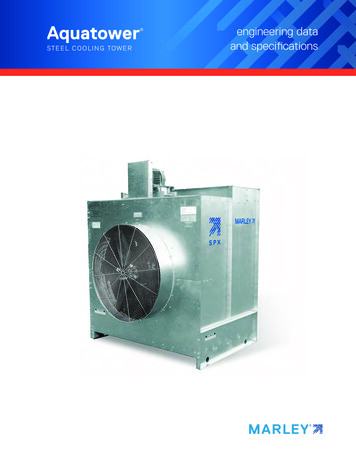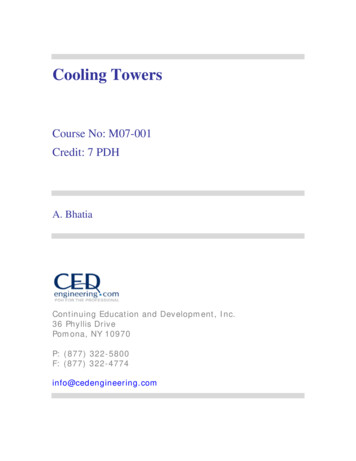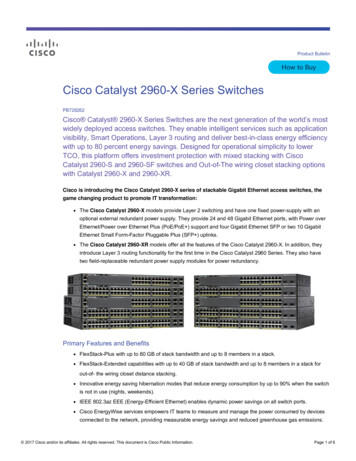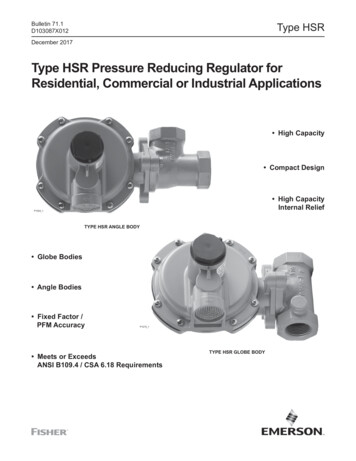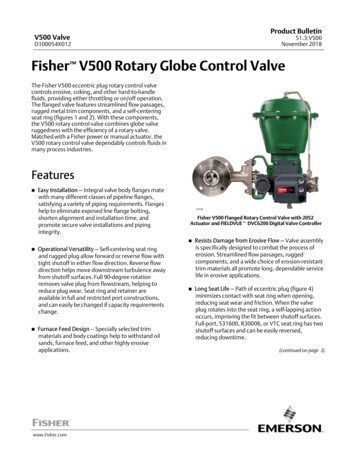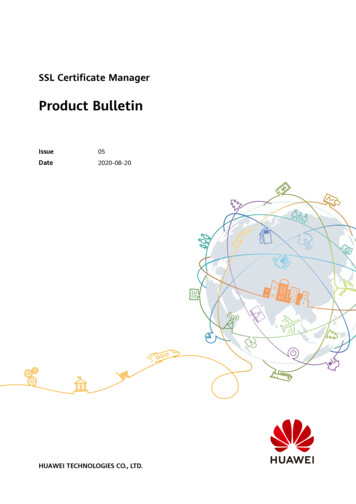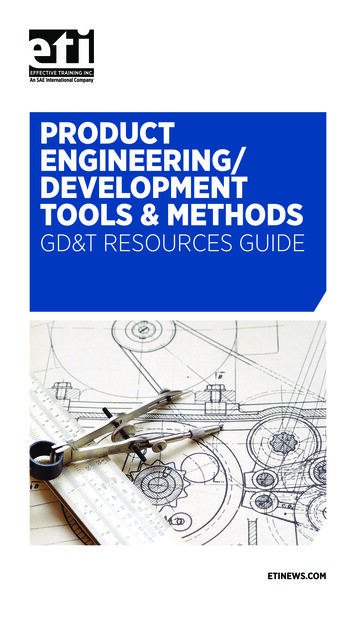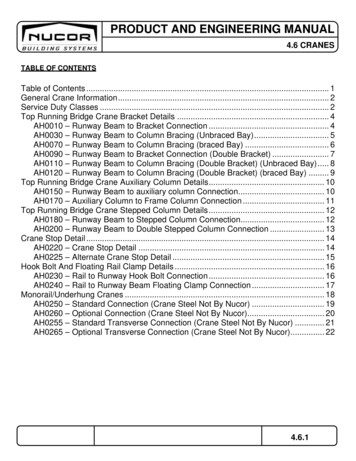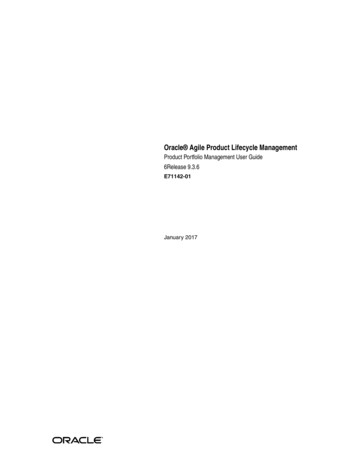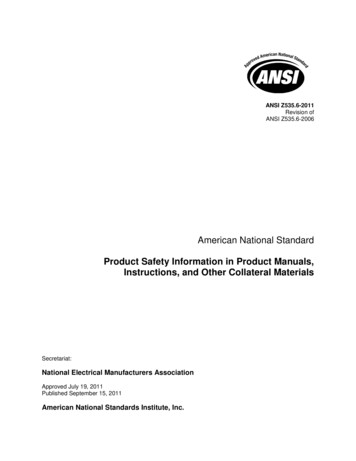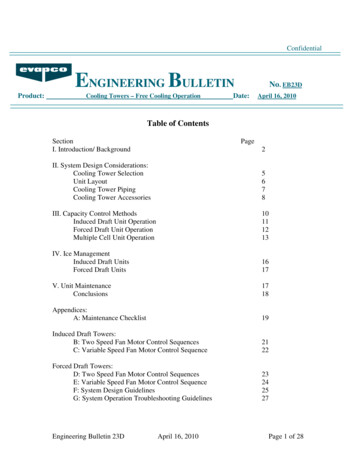
Transcription
ConfidentialENGINEERING BULLETINProduct:Cooling Towers – Free Cooling OperationNo. EB23DDate:April 16, 2010Table of ContentsSectionI. Introduction/ BackgroundPage2II. System Design Considerations:Cooling Tower SelectionUnit LayoutCooling Tower PipingCooling Tower Accessories5678III. Capacity Control MethodsInduced Draft Unit OperationForced Draft Unit OperationMultiple Cell Unit Operation10111213IV. Ice ManagementInduced Draft UnitsForced Draft Units1617V. Unit MaintenanceConclusions1718Appendices:A: Maintenance Checklist19Induced Draft Towers:B: Two Speed Fan Motor Control SequencesC: Variable Speed Fan Motor Control Sequence2122Forced Draft Towers:D: Two Speed Fan Motor Control SequencesE: Variable Speed Fan Motor Control SequenceF: System Design GuidelinesG: System Operation Troubleshooting Guidelines23242527Engineering Bulletin 23DApril 16, 2010Page 1 of 28
I. Introduction:Cooling towers are used to dissipate heat from air conditioning or industrialprocess systems. Many of the air conditioning systems currently in use onlyoperate during the summer cooling season, but there are numerous airconditioning and process systems that require cooling year-round. In somecases, the entire cooling system is required to operate during the winter. Thecooling tower is required to provide the same 85 F or colder water to the systemas it does in the summer, but it does so at lower ambient temperatures. However,there are some applications designed to use the cooling tower for “free cooling”.Free cooling is when chilled water is cooled by cooling tower water through theuse of heat exchangers without the use of refrigerant compressors. Free coolingcan be accomplished when ambient conditions allow the cooling tower toproduce “chilled water” for the system.When the tower is providing “chilled water” to the system, there are periods oftime when it must operate in subfreezing conditions. During these periods, whenthe tower is subjected to very cold ambient conditions, there is greater potentialto produce ice in the cooling tower or elsewhere in the system. If an inappropriatecooling tower design is chosen, or if the unit is not operated or winterizedproperly, excessive amounts of ice can form in the unit resulting in decreasedcapacity, operational difficulties, and potential damage to the tower.Cooling tower performance in free cooling applications is dependent upon boththe system and cooling tower design. The control sequences applied to thecooling system must consider management of both the air and water side of thecooling tower. It is essential that the proper control sequences be applied duringfree cooling to ensure adequate operation of the cooling tower during lowambient conditions.When a requirement for free cooling is specified for a project utilizing coolingtowers, certain considerations must be made from the very beginning of theproject design. First, special care must be taken when laying out the coolingtowers to prevent recirculation due to poor tower location and prevailing winds. Ifa strong prevailing wind is present, adding “wind walls” to an induced draft towershould be considered. Second, the cooling tower should be equipped with basicoptions such as basin heaters, electric water level control, and vibration switchesto prevent operational issues due to basin freezing if a remote sump is notpossible. Lastly, capacity control must also be carefully considered, especially ifthe winter cooling load is significantly less than the summer load. Shutting downindividual cells of a multiple cell cooling tower or employing a low-flow header ona singe cell should be utilized. A minimum leaving water temperature of 45 Fmust be maintained at all times.Evapco’s counterflow cooling towers are well suited for free cooling operation. Ina counterflow cooling tower, the fill is completely enclosed and protected fromEngineering Bulletin 23DApril 16, 2010Page 2 of 28
outside elements, such as wind, that can cause freezing of the fill pack in lowambient conditions. Additionally, the fill pack is supported from below to preventsagging in the event freezing should occur due to a system imbalance. The fans,fan motors, and drive systems of Evapco counterflow cooling towers are alsodesigned to be safely run in reverse at up to 50% normal fan speed. However,there are several items to consider when operating a counterflow cooling tower ina free cooling mode. This engineering bulletin will examine the following items indetail: cooling tower design considerations, capacity control and ice managementmethods for both forced and induced draft units, and proper maintenanceprocedures to ensure successful operation of the cooling tower during freecooling. The appendix to this bulletin includes a quick-reference summary of thevarious capacity control sequences as well as system design and troubleshootingguidelines.Background:Normal Operation:An examination of free cooling should begin with a review of the normaloperation of the cooling tower during the summer cooling season. The schematicshown in Figure 1 details the operation of the cooling system during typicalsummer conditions. The chiller is operational and cooling the system chilledwater. In a traditional system, the chilled water returns from the conditionedspace at 55 F where it has absorbed the heat from the conditioned space. It isthen cooled in the evaporator shell of the chiller before being sent back to theconditioned space at 45 F. For these conditions, the chiller and the coolingtower are operating while the heat exchanger shown is isolated from the systemand is not included in the system operation.Simultaneously, the cooling tower is absorbing the building load plus the heat ofcompression. The cooling tower then transfers this heat load to the atmosphere.In a typical air conditioning system, the water leaves the condenser shell of thechiller and enters the cooling tower at 95 F. The hot water is then cooled to 85 F and then sent back to the condenser shell of the chiller to continue the heattransfer process.Engineering Bulletin 23DApril 16, 2010Page 3 of 28
Free Cooling Operation:During free cooling, the chiller is not operating. The cooling tower absorbs thebuilding heat load and rejects it to the atmosphere. During the free coolingoperation, the cooling tower does not need to remove the heat of compressionsince the chiller is not operating. The chiller is isolated, and the water from thecooling tower and the conditioned space is bypassed to the heat exchanger. Lowambient conditions allow the cooling tower to provide “chilled water”temperatures as low as 45 F to the primary side of the heat exchanger where itabsorbs the building heat load before being returned to the cooling tower. A 2 Fapproach can be achieved in the heat exchanger where 47 F water on thesecondary side provides cooling to the building. Since the cooling loads and therequirement to remove the humidity from the building are reduced in the winter,the “free cooling” chilled water temperatures can be higher than those duringsummer operation. The temperatures shown in the schematic are typical but aredependent on system loads, winter design conditions, and desired buildingtemperatures. The design engineer is responsible for defining the systemparameters which will allow you to select an appropriate cooling tower for thefree cooling operation.Engineering Bulletin 23DApril 16, 2010Page 4 of 28
II. Free Cooling: System Design ConsiderationsWhen considering a free cooling application, it is important to properly plan thedesign of the cooling tower system. The following items should be consideredduring the design phase of a project: Cooling Tower Selection Unit Layout Cooling Tower Piping Cooling Tower Accessories Transition from Free Cooling to Mechanical CoolingCooling Tower Selection:The first item to consider when designing a cooling tower system is the primarydesign condition – summer conditions or winter (free cooling) conditions. Thisdesign condition will drive the unit selection. If the winter condition is driving theunit selection, a larger unit will be required than would be normally selected forsummer only operation. This occurs because it is more difficult for the coolingtower to reject heat at low ambient operating conditions. Further, although asingle cell unit may meet the summer and winter design conditions, a multiplecell unit may be a better selection for winter operation. Since the water flow ratefor winter operation may be less than the summer flow rate, it can beconcentrated in fewer cells, which allows the flow rate per cell to remain high,thus reducing the potential for ice formation inside the tower. Multiple cell unitsalso provide backup capacity if an operating cell requires defrosting or were tofail.Engineering Bulletin 23DApril 16, 2010Page 5 of 28
Unit Layout:Careful consideration must be given to the proper location and layout of thecooling tower(s) on every project. Adequate unobstructed air flow must beprovided for both the intake and discharge of the unit. It is imperative for coolingtowers used for free cooling that the equipment layout minimizes the potentialfor recirculation. During summer operation, recirculation can dramaticallyreduce the cooling tower capacity, however during winter operation it can resultin condensate freezing on the inlet louvers, fans, fan shafts, and fan screens.The buildup of ice in these areas can adversely affect air flow to the unit or, inmore severe cases, lead to failure of these components. EVAPCO stronglyencourages the use of a vibration switch on units that are to be used for winteroperation.See Figure 3 for correct and incorrect installations for forced and induced draftunits.Engineering Bulletin 23DApril 16, 2010Page 6 of 28
Cooling tower performance can be affected by prevailing winds. High windscan create icing conditions on the inlet louvers and fan screens, adverselyaffecting air flow to the tower. EVAPCO can install “wind walls” in its induceddraft cooling towers to help alleviate the problems associated withinstallations that experience high winds (see Figure 4).In addition, the prevailing winds in poor unit layouts can cause a downwardairflow of the moisture laden discharge air, which can condense on the unitsurfaces and quickly freeze. This phenomenon promotes ice formation on theinlet louvers of induced draft units and on the fans of forced draft units.For more information on cooling tower layout, please refer to EVAPCOEquipment Layout Bulletin 311.Cooling Tower Piping:When designing a cooling tower system for free cooling applications, severalpiping details should be considered to ensure proper winter operation of the unit.A cooling tower bypass needs to be incorporated into the system design to allowwater to “bypass” the tower’s water distribution system as a means of capacityEngineering Bulletin 23DApril 16, 2010Page 7 of 28
control during low load conditions. There are several ways to design the systempiping to accommodate the cooling tower bypass.EVAPCO recommends that the cooling tower bypass be installed in thecondenser water piping system. A bypass installed in this manner willrequire a section of pipe between the condenser water supply and returnleading to and from the cooling tower.Bypassing the cooling tower water directly into the cold water basin is anothermethod of a cooling tower bypass. Evapco can provide a factory installed bypassconnection in the cold water basin of the tower. Refer to Engineering Bulletin 33for further information on cooling tower bypass connections. In either method ofbypass (in the system piping or tower sump), it is good practice to install thebypass valve below the cold water basin level to assure good head pressure onthe valve.Regardless of what type of bypass arrangement is used, Evapco recommendsthat only a FULL FLOW BYPASS be used during free cooling operation. Thismeans that the total flow rate to the tower must either be sent to the waterdistribution system or bypassed. ALTHOUGH IT MAY BE ACCEPTABLE TOUSE A PARTIAL BYPASS DURING THE SUMMER, NEVER USE A PARTIALCOOLING TOWER BYPASS DURING FREE COOLING OPERATION!Reduced flow over the tower can result in uneven water flow over the heattransfer media (fill) which can cause scaling during summer operation and iceformation during winter operation.Freeze Protection:Another important consideration during free cooling system design is to ensurethat the necessary piping and accessories are heat traced and insulated. Allwater inside the cooling tower drains (by gravity) to the cold water basin – noadditional provisions are required within the cooling tower. However, all externalpiping that does not drain (makeup water lines, equalizers, and riser piping) mustbe heat traced and insulated to ensure that they do not freeze. System pipingaccessories (makeup water and control valves, water circulation pumps, andwater level control packages) also require heat tracing and insulation. If any ofthese items are not heat traced and insulated, the ensuing ice formation in thesecomponents may result in failure causing a shutdown of the cooling tower(s).Cooling Tower Accessories:The major concern when operating a cooling tower during the winter for freecooling is freeze protection. If a cooling tower does not have the appropriateaccessories, excessive amounts of ice may form inside or on the unit which couldlead to a significant reduction in thermal capacity or a catastrophic equipmentfailure. However, the appropriate accessories to prevent or minimize iceformation during free cooling operation are relatively simple and inexpensive.These accessories include multi-speed or inverter duty motor(s), wind walls,Engineering Bulletin 23DApril 16, 2010Page 8 of 28
extended drip angles, cold water basin heaters, remote sump connections,electronic water level control and vibration cutout switches. Each of theseaccessories ensures that the cooling tower will fu
cooling tower design is chosen, or if the unit is not operated or winterized properly, excessive amounts of ice can form in the unit resulting in decreased capacity, operational difficulties, and potential damage to the tower. Cooling tower performance in free cooling applications is dependent upon both the system and cooling tower design. The control sequences applied to theFile Size: 371KBPage Count: 28
